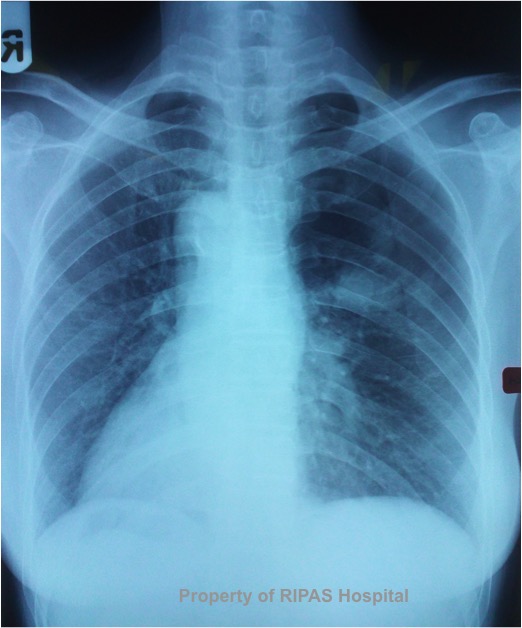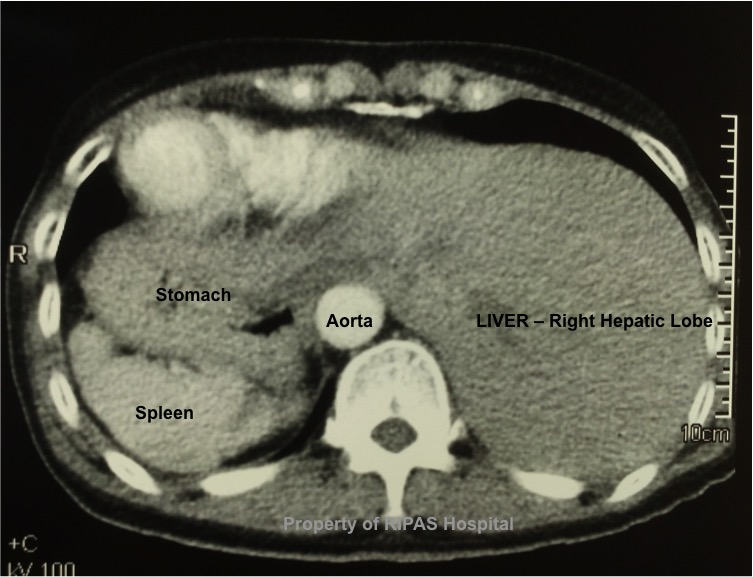IMAGE OF THE WEEK 2015
IMAGE 03 - 1 JUNE 2015
DEXTROCARDIA WITH SITUS INVERSUS
|
 |
 |
|
Figure 1a: PA x-ray of a middle aged female patient with dextrocardia
and two pulmonary shadows on the left lung field. (Click on image to
enlarge) |
Figure 1b: CT coronal section of the same patient showing the heart with
the apex in the right chest and liver on the left side indicating the
presence of dextrocardia with situs inversus. (Click on image to
enlarge)
|
Definitions:
Dextrocardia
is a congenital defect in which the apex of the heart is
situated on the right side of the body (Wikipedia (en.wikipedia.org/wiki/Dextrocardia)
with normal anatomical arrangements of the heart chambers, a perfect mirrored
inversion of the normal left heart. Incidence of dextrocardia is about 1 in
12000 population.
Situs Inversus
(also called situs transversus or oppositus) is a congenital condition in which
the major visceral organs are reversed or mirrored from their normal positions
(Wikipedia (en.wikipedia.org/wiki/Situs_inversus).
Incidence of situs inversus is about 0.01% of the population, or about 1 in
10,000 population.
Dextrocardia with Situs
Inversus is a rare congenital condition in which
all the normal anatomical organ arrangements are inverse from right to left.
Hence a patient with dextrocardia with situs inversus will have the heart in the
right chest with the position of the heart chambers as well as visceral organs
like the liver and spleen all reversed (situs inversus) from left to right
(heart and spleen – Figure 1 and 2) and right to left (Figure 2b).
|
 |
 |
|
Figure 2a: Transverse section of the CT scan of the thorax of the same
patient at the level of the cardiac chambers showing normal anatomical
arrangements of the cardiac chambers. (Click on image to
enlarge) |
Figure 2b: Transverse section of the CT scan of the abdomen of the same
patient at the level of the liver showing the inverse mirrored image of
situs inversus with the liver on the left and spleen and stomach on the
right. (Click on image to
enlarge)
|
Dextrocardia with situs inversus
is rare and is transmitted by autosomal recessive gene. During fetal
development, the primitive loop in the embryo moves into the reverse direction
from its normal position, resulting in displacement of the internal organs. Both
genders are equally affected.
Clinical Significance
Individuals with dextrocardia
with situs inversus can live a normal life without symptoms or disability.
Clinical significance is associated with knowing the condition and getting a
proper ECG readings by placing the leads on the right chest, a mirror reflection
of the normal left side chest leads. Similarly this applies to cardiopulmonary
resuscitation in which case the cardiac compression should be placed more
effectively towards the right side and also the pads for DC cardioversion should
be placed with the apex pad towards the right and sternal pad towards the left
side of the sternum.
In the presence of Situs
inversus totalis, abdominal symptoms can be confusing since the stomach is on
the right and liver is on the left. Hence epigastric symptoms may reflect
hepatic pathology such as cholecystitis and right hypocondrium symptoms may be
related to the stomach, in this case, common condition like gastritis may have
symptoms on the right. Similarly with the appendix on the left, appendicitis may
present with left iliac fossa pain.
Images and text contributed by
Mr William Chong, Thoracic Unit, Department of Surgeryy,RIPAS Hospital.
All
images are copyrighted and property of RIPAS Hospital.




